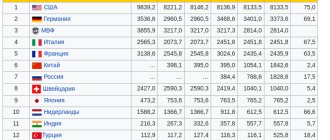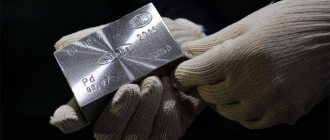Results of 2021. How the gold and foreign exchange reserves of the Russian Federation have changed
Gold and foreign exchange reserves (GFR) are liquid assets at the disposal of the Bank of Russia and the Government of the Russian Federation, used by them to finance the balance of payments deficit, influence the exchange rate through interventions, maintain confidence in the currency and economy of the Russian Federation, and also as a basis for foreign borrowing. Simply put, gold and foreign currency reserves are the safety margin of the national economy.
According to the management structure, funds are allocated under the management of the Ministry of Finance, included in gold and foreign exchange reserves - state funds, and under the management of the Central Bank - all other reserves.
State funds are special entities created to stabilize the economy. Until 2021, there were two of them: the Reserve Fund and the National Welfare Fund (NWF). Since 2021, the Reserve Fund has ceased to exist, having merged with the National Welfare Fund. The main goal of the National Welfare Fund is to provide co-financing of pension savings of citizens of the Russian Federation, as well as to cover the deficit of the federal budget and the budget of the Pension Fund of the Russian Federation.
The National Welfare Fund is formed from oil and gas revenues of the federal budget in accordance with the budget rule (read more in a special article) and from income from the management of the fund’s funds.
In 2021, funds in the accounts of the National Welfare Fund amounted to $68.55 billion or 4.6% of the country’s GDP. The growth rate was +5.2% since the beginning of the year. The ratio of the volume of NWF assets to GDP is important, since when the 7% mark is reached, the surplus can be used for investment in infrastructure projects.
At the same time, the delay between receiving income from the budget rule suggests that the fund will receive a significant part of the oil revenues for 2021 only in 2021. According to the forecast of the Ministry of Finance, the volume of the National Welfare Fund at the end of 2021 will amount to 7.8 trillion rubles, in 2021 it will grow to 11.37 trillion rubles, in 2021 - to 14.18 trillion rubles.
The structure of the country's gold and foreign currency reserves by type of asset is divided into two main categories: foreign exchange reserves and monetary gold. Foreign exchange reserves are a basket consisting of foreign currencies and debt securities denominated in them, as well as special drawing rights (SDRs) and the reserve position in the IMF. Monetary gold - gold bars and coins made of gold with a metal purity of at least 995/1000.
The total volume of gold and foreign currency reserves since 2014, against the backdrop of foreign exchange interventions to support the ruble, the country's reserves have decreased by 25%. The increase in reserves began only in 2015 and since then this process has continued.
As of December 1, 2021, Russia's gold and foreign currency reserves amounted to $462.1 billion, an increase of 6.8% compared to the beginning of the year. Both foreign exchange reserves and gold increased. Gold reserves amounted to $82.9 billion or 18% of all Russian reserves. Compared to January 1, 2021, the growth was 8.2%. Foreign exchange reserves over the same period increased by 6.5% to $379.2 billion.
It is worth considering that gold and foreign currency reserves are recorded in US dollars; accordingly, changes in gold prices and exchange rates affect the size of reserves. Since December 1, 2021, the price of gold has decreased by 3.7%, which means that the Bank of Russia's physical gold reserves increased by more than 12% during the period.
At the end of the third quarter of 2021, Russia ranks sixth in the world in terms of total gold and foreign exchange reserves.
The growth rate of Russia's gold and foreign currency reserves is one of the highest among the world's largest economies. In recent years, this trend has become even more pronounced. Sanction pressure is making itself felt, and the formation of a safety margin against this background looks quite logical.
Based on the criterion of adequacy of gold and foreign exchange reserves in months of imports, Russia ranks 8th in the world. The country is able to cover its imports of goods and services for 16 months. Saudi Arabia holds the maximum value - the country provides imports for 31 months.
Noticeable changes in the foreign exchange component of gold and foreign exchange reserves occurred in 2018 due to a reduction in the Russian Federation’s share in American debt securities. The policy of de-dollarization and growing tension in Russian-American relations, coupled with the threat of sanctions and the potential blocking of Russian assets, provoked a fair exit from US treasury securities.
If at the beginning of the year Russia held $96.9 billion in Treasuries, then as of September 2021, this amount decreased almost 7 times to $14.1 billion. At the same time, the amount of investments in securities in the structure of the currency component did not change so much: -9% by the beginning of the year, most likely there was a reorientation to the debt markets of Asia and Europe.
In general, the year turned out to be very favorable for the country's gold and currency reserves. The high cost of oil, which persisted throughout the year, provided additional income for the National Welfare Fund, which will be reflected on the balance sheet in 2021. The share of monetary gold continues to increase at a high pace. If tensions between Russia and the West do not decrease, the trend will continue.
The prospects for the country's gold and foreign exchange reserves in 2019-2021 are quite good. The forecast of the Ministry of Finance of the Russian Federation for oil assumes a significant excess of the price of fuel over the established limit within the framework of the budget rule (40.8 rubles per barrel), creating additional inflows into the National Welfare Fund. The projected budget and Pension Fund surplus in 2019-2020 will make it possible to save these funds and reach the target level of 7% in a relatively short time, which can create additional potential for the implementation of investment projects in the country.
BCS Broker
World gold reserves
An interesting situation emerges regarding gold reserves. We decided that the ranking would be better than the table. So:
- USA. These are the leaders in the gold and foreign exchange rating. As of today, the state has been able to increase its reserves compared to last year. The USA has 8133.5 tons of the purest minerals. Interestingly, the state was previously on the 5th line of the ranking.
- Germany. Gold reserves of 3373.6 tons give the Germans a well-deserved second place. This is 4 tons less than last year. However, officials said that, after many years, it was finally possible to withdraw German resources from the United States.
- Italy. This small state has had stable reserves of precious minerals for two decades. As of February 2021, the strategic arsenal has not changed and amounts to 2451.8 tons of gold.
- France. For the French, nothing has changed either: 2435.8 tons - these are the country’s gold reserves.
- China. Interestingly, until recently, China was considered the state with the largest gold and foreign exchange reserves. Now China is only in fifth place. In China, nothing has changed for several years: there are 1,842.6 tons of yellow metal in storage. At the same time, China's gold reserves are under reliable protection.
- Russia. The Central Bank is actively increasing its gold and foreign exchange reserves, and as of February 2021, the Russian Federation has 1857.8 tons in its storage facilities. The Krasnoyarsk Territory and Altai are on the list of leaders in gold production.
- Switzerland. The country is small, but that doesn’t stop it from being rich. To this day, 1040 tons of yellow metal lie in Switzerland.
- Japan. Yes, if we talk about gold and foreign exchange reserves by country, then in the overall ranking the state occupies eighth position. However, in East Asian countries it has secured second place. For 18 years, no one has changed the national reserves - they remain at around 765.2 tons.
- Netherlands. The small country is gradually increasing its reserves. As a result, there are 612.5 tons in storage.
- India. In our ranking, the state occupies tenth position. 557.8 tons of minerals are under reliable protection in foreign exchange funds.
If we talk about Canada’s gold reserves, this country managed to completely exhaust it in 2021. The public has accumulated certain questions about this matter for officials.
Kazakhstan's gold reserves began to suddenly increase. Now the country is one of the twenty countries with the largest reserves of precious minerals. In total, there are 285.7 tons in storage facilities in this country.
Total world reserves of the yellow fossil for 2021 are more than 30,000 tons.
United States gold reserves
As mentioned earlier, the largest reserve of gold in the world is located in the United States. This situation raises questions. At the same time, not only the Russian Federation, but also other countries are interested in the problem. Russian officials recall the fairy tale about Pinocchio, when the boy hid his modest money in the ground and hoped to save the money and make a profit.
The Germans were the first to be outraged. They called on America to send gold to its historical homeland. However, for the time being, no one agreed. But the German government still managed to do it. The supplies returned to the country after enormous efforts. But the United States has not lost its status as the country with the most yellow metals. This country of gold has only increased the stock of the metal in its vaults. Nothing happened to the economy.
You can go back in history to trace an interesting point. For example, after World War II, the USSR paid debts to America until the 70s, because the States were supplying food and military equipment in those days.
The whole problem is that the main world supply of gold is in the United States. There is nothing stopping the rulers from causing another economic crisis. The precious metal will be located mainly in America.
Purpose and management
Why do you need gold and foreign currency reserves? To ensure the money issued in the country, but not only. Its use makes it possible to impart stability to the financial system of the Russian Federation. The reserve allows you to cover the deficit in the balance of payments of the Russian Federation and maintain the ruble exchange rate at the required level. In addition, these funds can be used for financial assistance and loans to organizations and enterprises of other countries.
The main managers of the gold and foreign exchange reserves of the Bank of Russia are the Government of the Russian Federation and the Central Bank. The National Welfare Fund and the Reserve Fund are subordinate to the government. In 2018, the latter ceased to exist.
The influx of money into the country’s economy occurs through the purchase of gold and foreign currency, increasing the share of exports and reducing import costs, and lending to commercial banks. In the end, after investing the acquired currencies, the ruble becomes a kind of substitute for dollars and euros.
The Central Bank cannot independently issue as much money as the country needs (as happens in the USA). It is obvious that Russian money is not an independent currency , and its issuance occurs in accordance with the currency board system or currency board. In this case, the actual issue is carried out by central banks that issue an anchor currency (dollar, euro), to which the national currency rate of the state in question is fixed. The British were the first to introduce such a scheme to manage their colonies.
Gold of the Russian Empire under Tsar Nicholas II
Let me start with the fact that before the start of the First World War, the Russian Empire, through the efforts of Tsar Nicholas II, had the world's largest gold reserves. It was 1311 tons. In modern terms, this is approximately 150 billion US dollars.
SEE ALSO: THE WEST SUSPECTED THAT RUSSIA IS PREPARING A GOLD TRAP FOR THE USA
Subsequently, this reserve was significantly reduced. The World War and the October Revolution made adjustments. A certain amount of gold reserves went to pay for weapons and other assistance to the Entente countries in 1914-1917.
As a result, the gold reserves by the October Revolution of 1917 amounted to 1,100 tons.
After this, Russian gold partially fell into the hands of the White Czechs and White Guard generals, and was exported abroad. Including to Japan, Czech Republic, France, Great Britain. Where it is still located.
The Bolsheviks also had a hand in reducing the supply. For example, in the 1920s they spent more than 200 tons just buying steam locomotives from Europe. And part of the gold was paid to the Baltic countries. For example, Estonia received over 11 tons of gold under the Tartu Peace Treaty.
As a result, in 1923 the USSR's gold reserves were only 400 tons.










